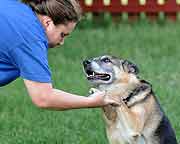
FRIDAY, July 15 (HealthDay News) — To anyone who is familiar with the eerily human-like qualities of man’s best friend, the news that dogs can read your mind shouldn’t come as any surprise.
The latest research adds to growing evidence that dogs can interpret both human body language and general behavior, and use it to their advantage.
“Dogs and [human-raised] wolves are capable of distinguishing between a person looking at them, someone who’s paying attention and someone who’s not,” said Monique A.R. Udell, lead author of a study published recently in the journal Learning & Behavior. “They’re more likely to beg [for food] from someone paying attention to them.”
Researchers have been learning more and more about the surprising capabilities and intelligence of Canis lupus familiaris, better known as the domestic dog.
One recent study found that dogs have the developmental abilities of a human 2-year-old, with the average dog capable of learning the meanings of 165 words.
“Over the last five years or so, we’ve been trying to understand how dogs and relatives of dogs such as wolves respond to social companions,” explained Udell, who was a researcher at the University of Florida in Gainesville when the study was conducted.
“The idea behind this particular study was to try to understand how it is, for example, that dogs can use cues of attention to predict what we’re going to do next and use that information to decide to beg for food from one individual and not another?” she continued. “How is it that dogs make us feel that they know what we’re thinking?”
The study involved groups of pet dogs, stray dogs from a shelter and hand-raised wolves (named Tristan, Miska and Marion, among other monikers) who were comfortable around humans.
Two people stood about 6 meters apart, one of them looking directly and continuously at the dog or wolf. The other person had their vision blocked, either with a bucket over their head, a book obscuring their face or because their back was turned. Both humans held a piece of food.
“On average, both dogs and wolves were significantly more likely to be begging from the person looking at them when the other person’s back was turned,” said Udell.
But levels of sensitivity did vary by how domesticated the dog or wolf was.
“Domesticated dogs were more likely to beg from someone paying attention to them, but shelter dogs and wolves who don’t often see a person reading books were not likely to get that cue,” Udell related. “So it does seem like specific life experiences really do matter in this context.”
The findings, said Udell, are “important because previous research suggested that something happened to dogs during genetic domestication that made them begin to think like humans. This shows that wolves are capable, if reared with humans, of [picking up human cues].”
“Animal people in the scientific community have known for some time that dogs are pretty smart and very good at reading our body language,” said Adam Goldfarb, director of the Pets at Risk Program of the Humane Society of the United States. “This shows that something about dogs or wolves inherently allows them to read humans far better than other animals can.”
More information
The Humane Society of the United States has more on canine behavior.

